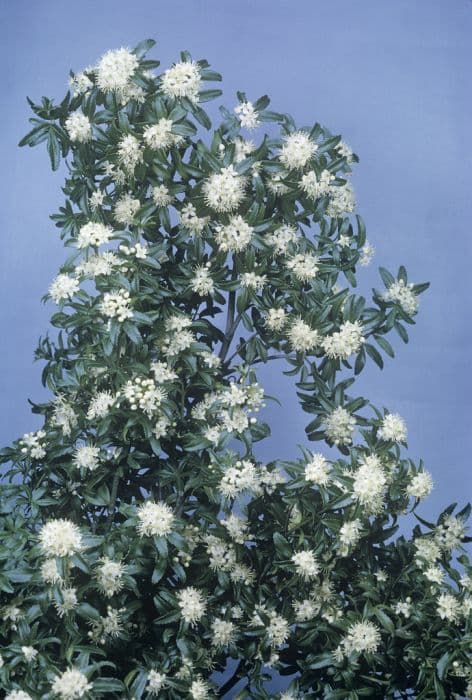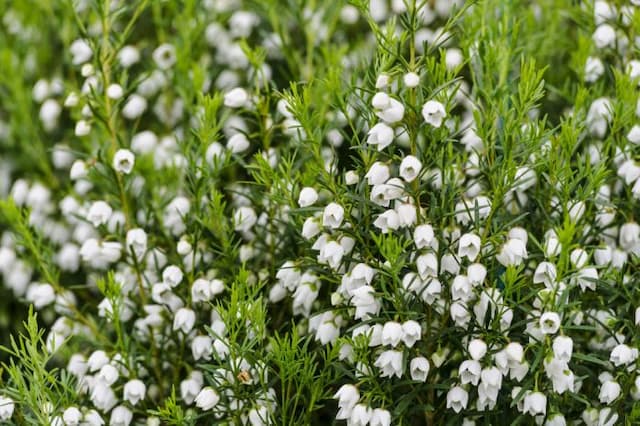Australian fuchsia 'Mannii' Correa 'Mannii'

ABOUT
'Mannii' is a tender evergreen shrub, up to 2.5m high. Dark green oval leaves have white undersides and hanging, long, bell-shaped flowers, 2.5cm long, scarlet outside and rose-pink inside, appear from autumn to spring
About this plant
 Names
NamesFamily
Rutaceae
Synonyms
Mann's Correa, Australian Fuchsia
Common names
Correa 'Mannii'.
 Characteristics
CharacteristicsLife cycle
Perennials
Foliage type
Evergreen
Color of leaves
Green
Flower color
Pink
Height
3-5 feet (0.91-1.52 meters)
Spread
3-5 feet (0.91-1.52 meters)
Plant type
Shrub
Hardiness zones
9
Native area
Australia
Benefits
 General Benefits
General Benefits- Attracts Wildlife: Correa 'Mannii', commonly known as Australian Fuchsia, attracts birds and beneficial insects to the garden, such as bees, which aid in pollination.
- Drought Tolerance: Once established, Australian Fuchsia exhibits good drought tolerance, making it suitable for dry climates and water-wise gardens.
- Low Maintenance: This plant typically requires minimal care, making it ideal for gardeners with limited time or those seeking low-maintenance landscaping options.
- Aesthetic Appeal: Australian Fuchsia offers attractive foliage and colorful tubular flowers, which can enhance the visual interest of a garden throughout its blooming season.
- Border Planting: With its compact size and dense growth habit, it can serve as an excellent choice for borders or as part of a mixed shrubbery display.
- Adaptability: It is capable of growing in a range of soil types, provided they are well-drained, adaptable to both full sun and partial shade conditions.
- Erosion Control: The dense foliage and root system can help stabilize soil and control erosion on slopes.
- Habitat Restoration: By including native plants like Australian Fuchsia in landscaping, gardeners can contribute to the restoration and support of local ecosystems.
 Medical Properties
Medical PropertiesThis plant is not used for medical purposes.
 Air-purifying Qualities
Air-purifying QualitiesThis plant is not specifically known for air purifying qualities.
 Other Uses
Other Uses- Correa 'Mannii', also known as Australian fuchsia, can be used in dye production. The leaves and flowers may contain tannins that can be useful for creating natural dyes for textiles.
- The dense foliage of Australian fuchsia makes it a perfect habitat for beneficial insects and small birds, providing shelter and nesting opportunities.
- The plant's woody branches can be used in small-scale crafting or as natural stakes in the garden to support other plants.
- Australian fuchsia can be used as a low-maintenance option for erosion control on slopes due to its robust root system.
- The flowers can serve as an attractive addition to foraging baskets, adding variety and a splash of color to edible blooms.
- As a winter-flowering plant, Australian fuchsia can be integrated into landscapes to provide visual interest during the colder months when many plants are not in bloom.
- The plant's durability allows it to serve as a protective ground cover in high traffic areas of the garden, reducing soil compaction.
- Its evergreen nature can be utilized in creating living sculptures or topiaries for year-round garden aesthetics.
- The nectar-rich flowers are a natural food source for wildlife, especially for nectar-feeding birds such as honeyeaters, aiding in the support of local ecosystems.
- Australian fuchsia's tolerance to coastal conditions makes it ideal for seaside gardens, offering ornamental value and resilience to salt spray.
Interesting Facts
 Feng Shui
Feng ShuiThe Australian Fuchsia is not used in Feng Shui practice.
 Zodiac Sign Compitability
Zodiac Sign CompitabilityThe Australian Fuchsia is not used in astrology practice.
 Plant Symbolism
Plant Symbolism- Adaptability: The Correa 'Mannii', commonly known as the Australian Fuchsia, has the ability to thrive in various conditions, symbolizing the capacity to adapt to different life situations.
- Resilience: This plant is known for its hardiness, representing the ability to withstand and recover from difficult conditions.
- Attraction: With its bell-shaped flowers, the Australian Fuchsia symbolizes allure and the ability to attract both humans and wildlife, like birds and bees, that are drawn to its nectar-rich blooms.
- Endurance: The Australian Fuchsia is a tough plant that can endure through challenging climates, representing persistence and the strength to endure over time.
 Water
WaterThe Australian Fuchsia should be watered regularly to maintain consistently moist soil, especially during the growing season in spring and summer. It is best to water this plant deeply once a week, allowing water to thoroughly saturate the root zone. Depending on the climate and weather conditions, this could be about 1 to 2 gallons each time for an established plant. During the fall and winter, reduce watering frequency as the plant's growth slows down, but do not let the soil completely dry out.
 Light
LightThe Australian Fuchsia prefers a spot with partial shade or dappled sunlight. Too much direct sun can scorch its leaves, whereas too little light can reduce flowering. Ideal locations would offer morning sunlight with protection from the intense afternoon sun, or bright indirect light if planted indoors.
 Temperature
TemperatureThe Australian Fuchsia thrives in moderate temperatures and can handle a range between 30 to 85 degrees Fahrenheit. However, the ideal temperature for optimum growth and flowering is between 50 to 75 degrees Fahrenheit. The plant is sensitive to extreme cold and should be protected from frost, which can damage the plant if temperatures fall below 30 degrees Fahrenheit.
 Pruning
PruningPruning the Australian Fuchsia is mainly done to maintain shape, remove dead or damaged wood, and encourage bushier growth. Light pruning can be carried out in late winter or early spring before new growth starts. Additionally, after flowering, trimming back the spent flowers can promote a second bloom and prevent the plant from using energy to produce seeds.
 Cleaning
CleaningAs needed
 Soil
SoilAustralian Fuchsia requires well-draining soil with a blend of potting mix, coarse sand, and peat for acidity. The optimal soil pH is slightly acidic to neutral, around 6-7.
 Repotting
RepottingAustralian Fuchsia should be repotted every 2-3 years or when it outgrows its current pot, ideally during springtime.
 Humidity & Misting
Humidity & MistingAustralian Fuchsia thrives in moderate humidity conditions; high humidity is not necessary, but ensure the air is not too dry.
 Suitable locations
Suitable locationsIndoor
Provide bright, indirect light and well-draining soil.
Outdoor
Plant in a sheltered spot with morning sun and well-draining soil.
Hardiness zone
9-11 USDA
 Life cycle
Life cycleThe life cycle of the Correa 'Mannii', commonly known as Australian Fuchsia, begins with seed germination, triggered by favorable environmental conditions, typically in moist, well-draining soil. Following germination, the seedling stage commences, during which the plant develops its first true leaves and a root system capable of absorbing nutrients from the soil. As the plant enters the vegetative growth stage, it develops a woody stem and a bushy form, with dense foliage and further root system development. During the flowering stage, which occurs usually in late autumn to early spring, Australian Fuchsia produces tubular bell-shaped flowers that attract pollinators and can result in the formation of fruit if pollination is successful. Upon maturity, the fruit will release seeds, completing the reproductive cycle. Finally, after several years of growth, depending on environmental factors, the plant reaches senescence, where growth slows and the plant eventually dies, though it can live for many years if maintained properly.
 Propogation
PropogationPropogation time
Spring-Early Summer
Propogation: The most popular method of propagation for the Correa 'Mannii', commonly known as Australian fuchsia, is through semi-hardwood cuttings. This technique is typically performed in late summer to early fall. To propagate, select a healthy stem with mature, semi-hardwood sections. Cut a piece about 4 to 6 inches (approximately 10 to 15 centimeters) long, below a leaf node, and remove the leaves from the lower half of the cutting to expose the nodes. Dip the cut end into a rooting hormone to promote root development and plant it in a well-draining soil mix. Keep the cutting in a warm, humid environment with indirect sunlight to encourage rooting. Roots usually develop within a few weeks, after which the new plant can be gradually acclimatized to less controlled conditions before being planted in a permanent location.


![Mexican orange [Sundance]](/_next/image?url=https%3A%2F%2Fplants-admin.emdemapps.com%2Fimages%2Fplants%2F%2Fimages%2F604b5381bcf0d.png&w=640&q=75)






![Mexican orange [Goldfingers]](/_next/image?url=https%3A%2F%2Fplants-admin.emdemapps.com%2Fimages%2Fplants%2F%2Fimages%2F604b5bdfad8cd.png&w=640&q=75)